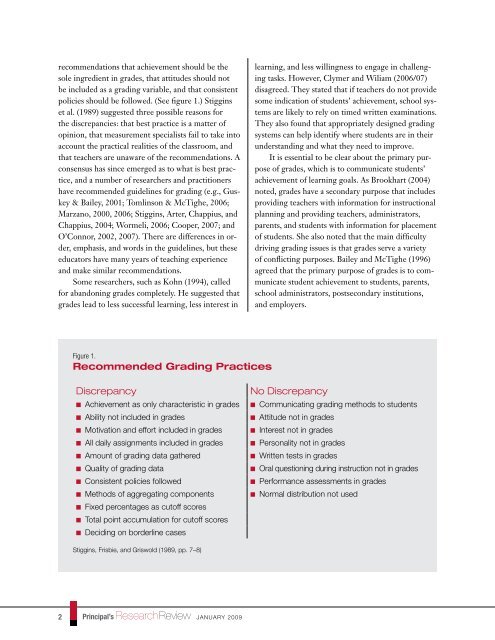Reforming Grading Practices in Secondary Schools - eStaffRoom
Reforming Grading Practices in Secondary Schools - eStaffRoom
Reforming Grading Practices in Secondary Schools - eStaffRoom
You also want an ePaper? Increase the reach of your titles
YUMPU automatically turns print PDFs into web optimized ePapers that Google loves.
ecommendations that achievement should be the<br />
sole <strong>in</strong>gredient <strong>in</strong> grades, that attitudes should not<br />
be <strong>in</strong>cluded as a grad<strong>in</strong>g variable, and that consistent<br />
policies should be followed. (See figure 1.) Stigg<strong>in</strong>s<br />
et al. (1989) suggested three possible reasons for<br />
the discrepancies: that best practice is a matter of<br />
op<strong>in</strong>ion, that measurement specialists fail to take <strong>in</strong>to<br />
account the practical realities of the classroom, and<br />
that teachers are unaware of the recommendations. A<br />
consensus has s<strong>in</strong>ce emerged as to what is best practice,<br />
and a number of researchers and practitioners<br />
have recommended guidel<strong>in</strong>es for grad<strong>in</strong>g (e.g., Guskey<br />
& Bailey, 2001; Toml<strong>in</strong>son & McTighe, 2006;<br />
Marzano, 2000, 2006; Stigg<strong>in</strong>s, Arter, Chappius, and<br />
Chappius, 2004; Wormeli, 2006; Cooper, 2007; and<br />
O’Connor, 2002, 2007). There are differences <strong>in</strong> order,<br />
emphasis, and words <strong>in</strong> the guidel<strong>in</strong>es, but these<br />
educators have many years of teach<strong>in</strong>g experience<br />
and make similar recommendations.<br />
Some researchers, such as Kohn (1994), called<br />
for abandon<strong>in</strong>g grades completely. He suggested that<br />
grades lead to less successful learn<strong>in</strong>g, less <strong>in</strong>terest <strong>in</strong><br />
learn<strong>in</strong>g, and less will<strong>in</strong>gness to engage <strong>in</strong> challeng<strong>in</strong>g<br />
tasks. However, Clymer and Wiliam (2006/07)<br />
disagreed. They stated that if teachers do not provide<br />
some <strong>in</strong>dication of students’ achievement, school systems<br />
are likely to rely on timed written exam<strong>in</strong>ations.<br />
They also found that appropriately designed grad<strong>in</strong>g<br />
systems can help identify where students are <strong>in</strong> their<br />
understand<strong>in</strong>g and what they need to improve.<br />
It is essential to be clear about the primary purpose<br />
of grades, which is to communicate students’<br />
achievement of learn<strong>in</strong>g goals. As Brookhart (2004)<br />
noted, grades have a secondary purpose that <strong>in</strong>cludes<br />
provid<strong>in</strong>g teachers with <strong>in</strong>formation for <strong>in</strong>structional<br />
plann<strong>in</strong>g and provid<strong>in</strong>g teachers, adm<strong>in</strong>istrators,<br />
parents, and students with <strong>in</strong>formation for placement<br />
of students. She also noted that the ma<strong>in</strong> difficulty<br />
driv<strong>in</strong>g grad<strong>in</strong>g issues is that grades serve a variety<br />
of conflict<strong>in</strong>g purposes. Bailey and McTighe (1996)<br />
agreed that the primary purpose of grades is to communicate<br />
student achievement to students, parents,<br />
school adm<strong>in</strong>istrators, postsecondary <strong>in</strong>stitutions,<br />
and employers.<br />
Figure 1.<br />
Recommended <strong>Grad<strong>in</strong>g</strong> <strong>Practices</strong><br />
Discrepancy<br />
n Achievement as only characteristic <strong>in</strong> grades<br />
n Ability not <strong>in</strong>cluded <strong>in</strong> grades<br />
n Motivation and effort <strong>in</strong>cluded <strong>in</strong> grades<br />
n All daily assignments <strong>in</strong>cluded <strong>in</strong> grades<br />
n Amount of grad<strong>in</strong>g data gathered<br />
n Quality of grad<strong>in</strong>g data<br />
n Consistent policies followed<br />
n Methods of aggregat<strong>in</strong>g components<br />
n Fixed percentages as cutoff scores<br />
n Total po<strong>in</strong>t accumulation for cutoff scores<br />
n Decid<strong>in</strong>g on borderl<strong>in</strong>e cases<br />
No Discrepancy<br />
n Communicat<strong>in</strong>g grad<strong>in</strong>g methods to students<br />
n Attitude not <strong>in</strong> grades<br />
n Interest not <strong>in</strong> grades<br />
n Personality not <strong>in</strong> grades<br />
n Written tests <strong>in</strong> grades<br />
n Oral question<strong>in</strong>g dur<strong>in</strong>g <strong>in</strong>struction not <strong>in</strong> grades<br />
n Performance assessments <strong>in</strong> grades<br />
n Normal distribution not used<br />
Stigg<strong>in</strong>s, Frisbie, and Griswold (1989, pp. 7–8)<br />
2<br />
Pr<strong>in</strong>cipal’s ResearchReview january 2009






